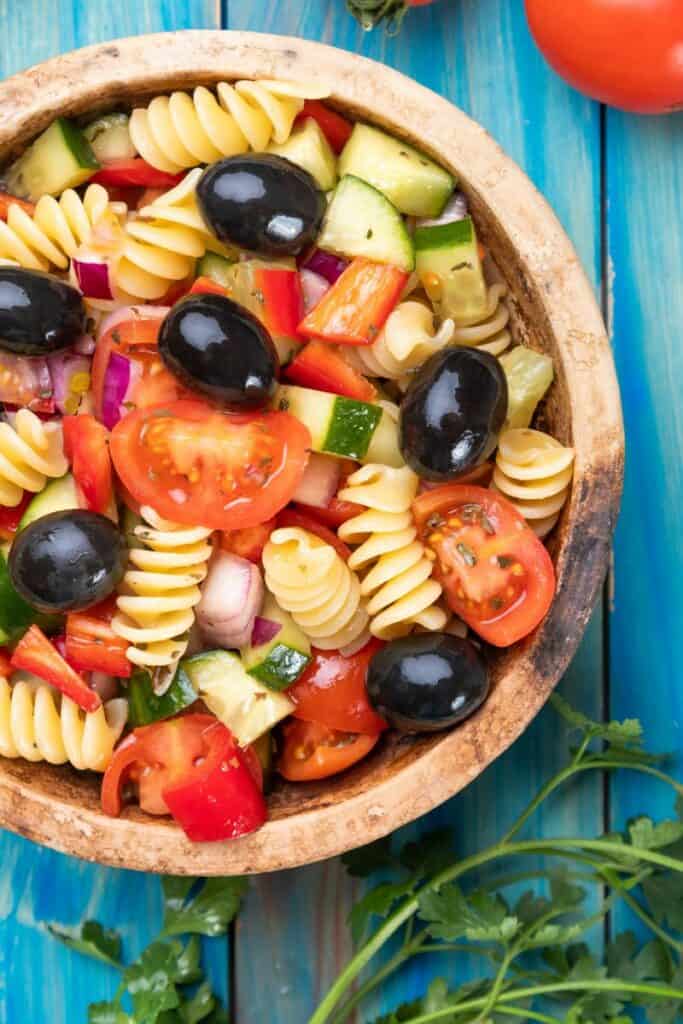Pasta salad is one of my favorite recipes to make. There are so many possible ingredients to use, and they can work as a side dish or meal of their own!
I often make pasta salad in large quantities, which means there are always leftovers. Leftover pasta salad is a wonderful snack or meal, but not when it’s spoiled!
So, how long is pasta salad good for in the fridge? Most pasta salad will last up to 5 days in the fridge.

This post may contain affiliate links. If you click on a link and make a purchase, I may receive a small commission at no extra cost to you. For more information, please read my disclaimer.
How to Keep Pasta Salad Fresh
To make pasta salad last in the fridge, it’s important that it is stored in an airtight container. This keeps it from drying out and prevents bacteria growth.
A great way to keep pasta salad fresh is to keep the dressing separate from the pasta until it’s being served. This way, your pasta will stay fresher, and you can prevent it from getting soggy.
Is Pasta Salad Good After 5 Days?
Both oil and dairy-based pasta salads should last between three and five days in the refrigerator. Pasta salads made with mayonnaise or other dairy ingredients might only last closer to four days.
No matter what is in your pasta salad, you should not consume it after five days.
Even if it has been properly stored and refrigerated, there is still a possibility that bacteria has started to grow or that ingredients have started to spoil.
How Long Can Pasta Salad Stay Out of the Fridge?
Whether you’ve made a creamy pasta salad, an Italian pasta salad, a pesto salad, or any pasta-and-salad combo under the sun, you should absolutely discard it if it’s been unrefrigerated for more than two hours.
Pasta salad left at room temperature for more than two hours is highly likely to have been spoiled.
Especially in higher-temperature rooms, any food left unrefrigerated is prone to bacteria growth which can lead to serious illnesses.
Can You Leave Pasta Salad at Room Temperature?
Yes, but only for less than two hours. Keep your pasta salad in the refrigerator for as long as possible before serving.
If you’re hosting a dinner party or a barbecue, consider placing the serving bowl inside of a larger bowl filled with ice. This will help keep the food chilled and fresh.
Keep the dish in the shade and out of direct sunlight, and be sure to keep it covered! Not only will it aid it cooling the pasta salad, but it will protect it from bugs too.

How to Tell if Pasta Salad is Bad
It’s always a good idea to label your leftover containers. This will help keep track of how long they have been in the fridge.
Otherwise, there are a few easy ways to tell if your pasta salad has gone bad:
- Take a look. Check for any sign of mold. It may be white and fuzzy or green and black specks. Toss it right away if you notice any in the dish.
- Give it a sniff. If you smell anything sour or unpleasant, you may be dealing with some spoiled or rotten foods. Discard the pasta immediately.
- Try a taste. Barring mold, you can always take a small bite to see if your pasta salad tastes okay.
If your pasta salad looks, smells, and tastes fine, it is likely, not bad. However, if you’re unsure, it’s always safer to assume that it has spoiled. Better to be safe than sorry with food poisoning!
Can You Freeze Pasta Salad?
In most cases, pasta salad does not freeze well.
Dressings and cheeses develop an unpleasant texture when thawed, and veggies often become wilted or soggy.
However, there are some exceptions. If the individual ingredients tend to freeze well, then you should be safe!
- Undercook your pasta. This will prevent it from turning to mush when thawed.
- Freeze ingredients separately. Store pasta and mix-ins in different containers, then thaw and combine before serving.
- Remove as much air as possible. You want to limit the possibility of ice crystals or absorbing odors from the freezer.
- Skip the dressing. Both oil and mayonnaise-based sauces will separate when thawed. Best to make them fresh!

Can I Put Warm Pasta Salad in the Refrigerator?
Avoid putting warm pasta salad directly in the refrigerator. The rapid change in temperature can cause bacteria growth, and the steam trapped in the container can cause ingredients to get soggy.
Instead, allow the dish to cool for up to an hour before placing it in the fridge.
